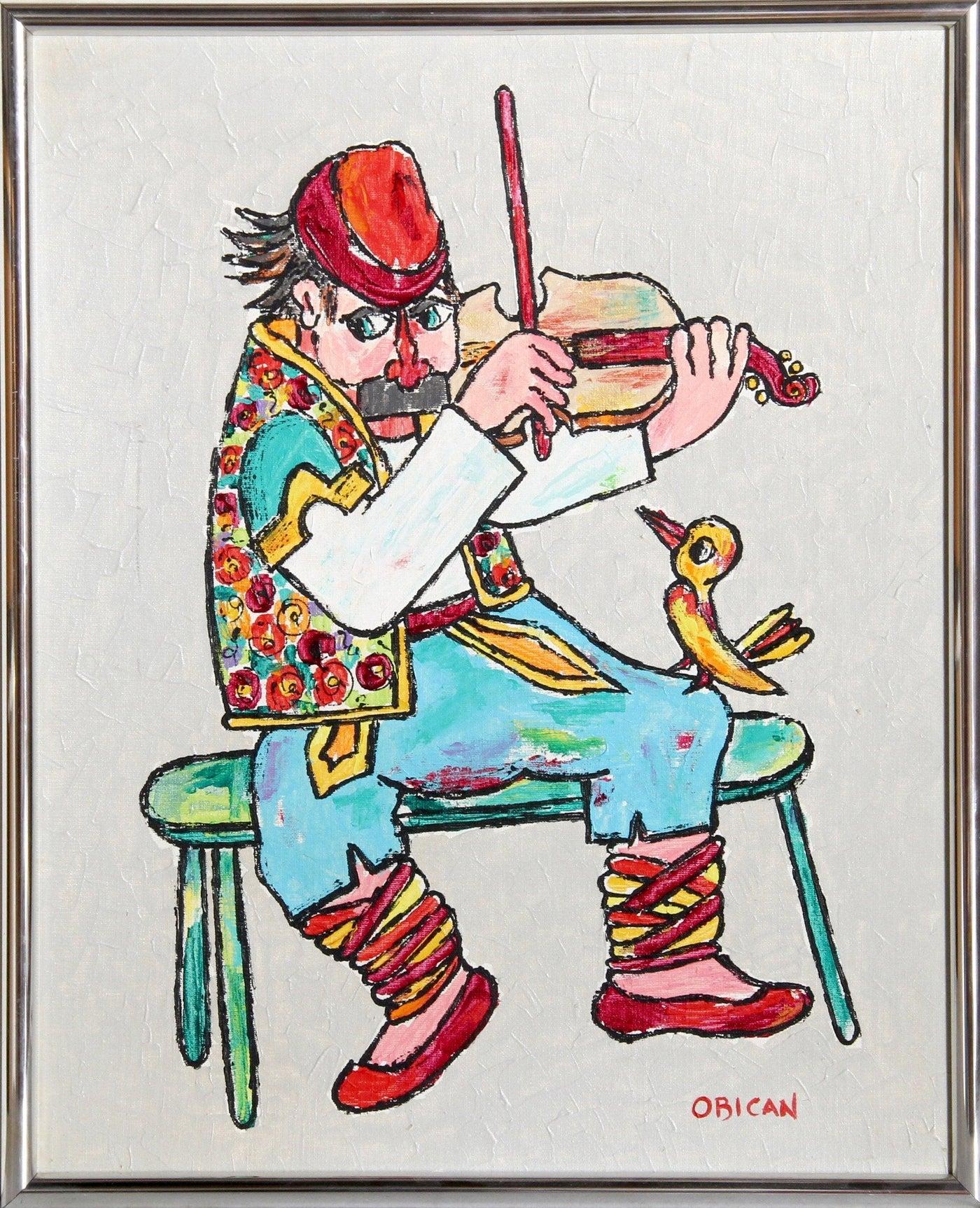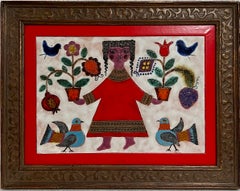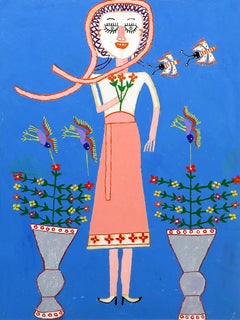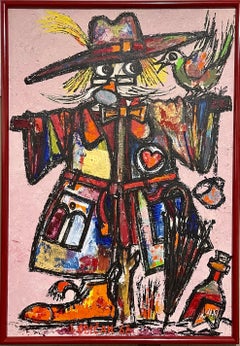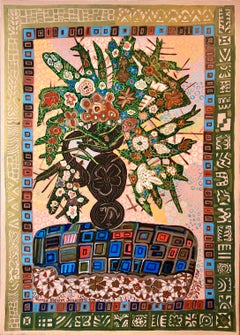Items Similar to Green Man with Flower and Bird, Signed Acrylic on Paper by Jovan Obican
Want more images or videos?
Request additional images or videos from the seller
1 of 6
Jovan ObicanGreen Man with Flower and Bird, Signed Acrylic on Paper by Jovan Obicancirca 1980
circa 1980
$1,800
£1,338.10
€1,566.48
CA$2,517.25
A$2,810.78
CHF 1,466.18
MX$34,562.70
NOK 18,505
SEK 17,421.80
DKK 11,685.91
Shipping
Retrieving quote...The 1stDibs Promise:
Authenticity Guarantee,
Money-Back Guarantee,
24-Hour Cancellation
About the Item
Green Man with Flower and Bird
Jovan Obican
French/Yugoslavian (1918–1986)
Acrylic on Paper, signed l.l.
Size: 27.5 in. x 19 in. (69.85 cm x 48.26 cm)
- Creator:Jovan Obican (1918-1986, French)
- Creation Year:circa 1980
- Dimensions:Height: 27.5 in (69.85 cm)Width: 19 in (48.26 cm)
- Medium:
- Movement & Style:
- Period:
- Condition:
- Gallery Location:Long Island City, NY
- Reference Number:Seller: RO430251stDibs: LU46615802492
About the Seller
4.9
Platinum Seller
Premium sellers with a 4.7+ rating and 24-hour response times
Established in 1979
1stDibs seller since 2014
3,033 sales on 1stDibs
Typical response time: 1 hour
- ShippingRetrieving quote...Shipping from: Long Island City, NY
- Return Policy
Authenticity Guarantee
In the unlikely event there’s an issue with an item’s authenticity, contact us within 1 year for a full refund. DetailsMoney-Back Guarantee
If your item is not as described, is damaged in transit, or does not arrive, contact us within 7 days for a full refund. Details24-Hour Cancellation
You have a 24-hour grace period in which to reconsider your purchase, with no questions asked.Vetted Professional Sellers
Our world-class sellers must adhere to strict standards for service and quality, maintaining the integrity of our listings.Price-Match Guarantee
If you find that a seller listed the same item for a lower price elsewhere, we’ll match it.Trusted Global Delivery
Our best-in-class carrier network provides specialized shipping options worldwide, including custom delivery.More From This Seller
View AllMan with Flower and Bird, Signed Oil on Board by Jovan Obican
By Jovan Obican
Located in Long Island City, NY
Man with Flower and Bird
Jovan Obican
French/Yugoslavian (1918–1986)
Date: circa 1980
Oil on board
Size: 28 x 22 in. (71.12 x 55.88 cm)
Frame Size: 30 x 24 inches
Category
1980s Folk Art Paintings
Materials
Oil
Man with Flower and Birds, Oil on Board Folk Art Painting by Jovan Obican
By Jovan Obican
Located in Long Island City, NY
Man with Flower and Birds
Jovan Obican
French/Yugoslavian (1918–1986)
Date: circa 1980
Oil on board
Size: 9 x 7 in. (22.86 x 17.78 cm)
Frame Size: 9.75 x 7.25 inches
Category
1980s Folk Art Paintings
Materials
Oil
Man with Yellow Bird, Signed Oil on Board by Jovan Obican
By Jovan Obican
Located in Long Island City, NY
Man with Yellow Bird
Jovan Obican
French/Yugoslavian (1918–1986)
Oil on Board, signed l.l.
Size: 29.5 x 23.5 in. (74.93 x 59.69 cm)
Frame Size: 32 x 25.5 inches
Category
1980s Folk Art Paintings
Materials
Oil
Woman with Flowers, Watercolor Folk Art by Jovan Obican
By Jovan Obican
Located in Long Island City, NY
Woman with Flowers
Jovan Obican
French/Yugoslavian (1918–1986)
Date: circa 1980
Watercolor on Paper
Size: 27.5 x 19 in. (69.85 x 48.26 cm)
Frame Size: 30.5 x 22.5 inches
Category
1980s Folk Art Drawings and Watercolor Paintings
Materials
Watercolor
Scarecrow, 1983 Signed Oil Painting by Jovan Obican
By Jovan Obican
Located in Long Island City, NY
Scarecrow
Jovan Obican
French/Yugoslavian (1918–1986)
Date: 1983
Oil on Canvas, signed l.l.
Size: 40 x 30 in. (101.6 x 76.2 cm)
Frame Size: 43 x 32.5 inches
Category
1980s Folk Art Paintings
Materials
Oil
Fiddler, Signed Folk Art Oil on Board by Jovan Obican
By Jovan Obican
Located in Long Island City, NY
Fiddler
Jovan Obican
French/Yugoslavian (1918–1986)
Date: circa 1980
Oil on board
Size: 16 x 20 in. (40.64 x 50.8 cm)
Frame Size: 21 x 17 inches
Category
1980s Folk Art Paintings
Materials
Oil
You May Also Like
Girl & Plants Enamel Glazed Ceramic Plaque Israeli Artist Awret Naive Folk Art
By Irene Awret
Located in Surfside, FL
This is a rare ceramic plaque painted with enamel glaze by famed Israeli German artist Irene Awret (these are generally hand signed Awret Safed on the verso. I just have not opened the frame to check) the actual glazed ceramic is 10.25 X 14.75 inches.
It depicts a girl or woman with potted plants, birds, pomegranates and other fruits and flowers in a naif, folk art style.
Irène Awret was born to a Jewish family in Berlin called Spicker, the youngest of three children. Her mother died in 1927, when Irène was six years old. In 1937 she was forced to stop high school, due to the Nazi race laws. Because she could not continue her regular studies, her father sent her to study drawing, painting and art restoration with a Jewish painter. Among his students were a large number of German Jews who knew they would have to leave Germany within a short time and would require a profession to enable them to support themselves.
When the situation grew worse, following the Kristallnacht (the first major attack on German and Austrian Jews in November 1938), her uncle decided to move to Belgium. In 1939 the situation became even worse - her father was fired from his job and the family were forced to leave their home. As a result, Awret's father tried to send her and her sister to Belgium, with the help of smugglers. The first smuggler proved to be a double agent and they were sent back from Aachen to Berlin. Two weeks later they made a second, successful, attempt to sneak across the border.
Awret worked for a Dutch Jewish family as a maid. As she had her room and board there, she was able to save enough money to study art part-time at Brussels' Académie Royal des Beaux-Arts. A few months later Awret's father joined her and her financial situation became easier. She left her job and studied full-time, helping support herself with restoration work when it was available and by painting portraits to order.
Later, Awret found a hiding place on a farm in Waterloo with a Jewish family who were connected with the underground. In January 1943 she had to return to Brussels, living with a false identity card which stated she was a married woman with two children. Awret succeeded in renting an attic without informing the police where she was - she told her landlady that she had been forced to flee her husband because he beat her. While there, she supported herself by restoring wooden sculptures.
A Jewish informer gave her up to the Gestapo, accompanying the two Gestapo men who arrested her. Awret was able to take a bag containing food and drawing materials. She was detained in the Gestapo cellars in Brussels where she drew. Because there was nothing there to draw, she sketched her own hand (view this work). Awret was interrogated in order to reveal the hiding place of her father who was still in Brussels. The National Socialist regime was determined to persecute him, even though he had fought for Germany in World War I and been permanently disabled. They stepped up their torture and brought Awret before Hartmann, the head of the Gestapo in Brussels. When Hartmann saw her block of drawings, he asked her where she had studied art and halted the interrogation.
Awret was placed in a narrow cell and then transferred to Malines camp, which the Belgian's called Mechelen. Malines was a transit camp to Auschwitz, regularly sending 2000 people at a time. Although she arrived just before Transport No. 20, Irène Awret avoided being included. Instead she was put to work in the leather workshop, decorating broaches. While she was there, Hartmann visited the camp and spotted her: "I could have discovered where your father is hiding," he told her. When her artistic talents became known, she was transferred to the Mahlerstube (artist's workshop) where she worked producing graphics for the Germans until the end of the war. When Carol (Karel) Deutsch (whose works are now on view at Yad Vashem) was sent from Mechelen to his death with his wife, he left young Irene his paintbox. Irene also recalls seeing the great painter Felix Nussbaum and his wife being pushed into a boxcar bound for the gas, and tells of the aftermath of the famous 20th Train incident, when a young Jewish doctor armed only with a pistol and helped by two unarmed friends with a lantern ambushed one of Mechelen's Auschwitz-bound trains carrying 1,618 Jews, most of whom had fled Eastern Europe for Belgium.
Awret's job enabled her to paint and draw - mainly in pencil, but also in watercolors and oils. In the artists' workshop she met a Jewish refugee from Poland - Azriel Awret - who would later become her husband. Among the other artists in the workshop were Herbert von Ledermann-Vütemberg, a sculptor from an aristocratic family with Jewish roots, Léon Landau, and Smilowitz, who perished in the camps in the East. Irène and Azriel tried to bribe a German officer to prevent Smilowitz's deportation. Not only were they unsuccessful, but they were almost put onto the same train. Jacques Ochs was another artist with whom they became friends in the camp. Ochs, a French-born Protestant who lived in Belgium, was interned as a political prisoner. He remained in Belgium after liberation.
After the war the Awrets immigrated to Israel and made their home in Safed. They continued to work, and were instrumental in founding Safed's artists' quarter.
The Beit Lohamei Haghetaot (Ghetto Fighters' House Museum) art collection holds works donated by Awret. These date from her time in Malines camp and from her stay in Brussels after the war, when she was in the company of orphans who had hidden while their parents were sent to Auschwitz. Her highly expressive works have made their way to exhibitions at theTel Aviv Museum, the Haifa Museum of Modern Art and the Modern Art Gallery in Washington, D.C., as well as into the private collections of such individuals as Dr. Jonas Salk...
Category
1950s Expressionist Figurative Paintings
Materials
Enamel
Original Naïve Folk Art Oil Painting by Martin Saldaña – Whimsical Girl, Flowers
By Martin Saldana
Located in Denver, CO
This enchanting original oil painting, Pinky, is a beautiful example of whimsical Naïve folk art by the artist Martin Saldaña. The artwork features a charming portrait of a young gir...
Category
1950s Folk Art Figurative Paintings
Materials
Oil
Large Naive European Folk Art Oil Painting Lazar Obican French Scarecrow Clown
Located in Surfside, FL
Lazar Obican 1944-2004
Genre: Other
Subject: People
Medium: Oil
Surface: Canvas
Dimensions: 35" x 16.5
Dimensions w/Frame: 35.5" x 17.25
An impasto composition that depicts a colorful scarecrow clown with a bird perched on his shoulder with a bottle of French Vin (wine)
Artist signature L OBICAN to bottom and dated 1968. Title to verso.
Work Size: 36 x 25 in. Framed 37.5 x 26 x 1 in
The artist Lazar Obican iconic style is child-like yet masterfully adult; a style that tells a story with sociological overtones. His funny little people are always colorful, full of spirit, living with music and birds to bring them happiness.
Lazar Obican artist, painter, sculpture and mosaic ceramic artisan was born in Cannes, France, to his Yugoslavian family. He finished his training, imbued with the spirit of his native country, the people, their legends, and their philosophy. It has been said that his work has a "timeless quality" and a naive, folk art, outsider art brut quality, child-like primitive style. Obican is identified with his style the world over, a style that is simple yet sophisticated; child-like yet masterfully adult; a style that tells a story with psychological, philosophical or sociological overtones. His funny little people are always colorful, full of spirit, living with music and birds to bring them happiness. Best known for his depictions of folklore and traditional costumes rendered in a playful, childlike style and for his happy Jewish wedding scenes. He often used bright colors and black outlines in his renderings of figures and animals, giving his work an illustration-like quality. Thematically, the artist’s work is similar to Marc Chagall and Jean Dubuffet for its dreamlike images and so-called naïve style of painting. Over the course of his career, the artist maintained a studio in Boca Raton, Florida and Dubrovnik, Croatia—part of former Yugoslavia— where he developed an interest in Eastern Europe’s Jewish culture. Many of his mature works depict Jewish traditions and ceremonies, including traditional Jewish weddings, the dancing of the Hora, and traditional music. There is a display of his works in his former Dubrovnik studio.
His style is a unique conglomerate of tradition, history, legends, heroes, old customs and folklore. It is a self-standing style, recognizable, cheerful, whimsical and a happy creation. Naïve art is any form of visual art that is created by a person who lacks the formal education and training that a professional artist undergoes (in anatomy, art history, technique, perspective, ways of seeing). Unlike folk art, naïve art does not necessarily evince a distinct cultural context or tradition. Naïve art is recognized, and often imitated, for its childlike simplicity and frankness. Paintings of this kind typically have a flat rendering style with a rudimentary expression of perspective.
One particularly influential painter of "naïve art" was Henri Rousseau (1844–1910), a French Post-Impressionist who was discovered by Pablo Picasso. Naïve art is often seen as outsider art that is by someone without formal (or little) training or degree. While this was true before the twentieth century, there are now academies for naïve art. Naïve art is now a fully recognized art genre, represented in art galleries worldwide.
Museums devoted to naïve art now exist in Kecskemét, Hungary; Riga, Latvia; Jaen, Spain; Rio de Janeiro, Brasil; Vicq France and Paris. "Primitive art" is another term often applied to art by those without formal training, but is historically more often applied to work from certain cultures that have been judged socially or technologically "primitive" by Western academia, such as Native American, sub saharan African or Pacific Island art (see Tribal art). This is distinguished from the self-conscious, "primitive" inspired movement primitivism. Another term related to (but not completely synonymous with) naïve art is folk art. There also exist the terms "naïvism" and "primitivism" which are usually applied to professional painters working in the style of naïve art (like Paul Gauguin, Mikhail Larionov, Paul Klee).
At all events, naive art can be regarded as having occupied an "official" position in the annals of twentieth-century art since - at the very latest - the publication of the Der Blaue Reiter, an almanac in 1912. Wassily Kandinsky and Franz Marc, who brought out the almanac, presented 6 reproductions of paintings by le Douanier' Rousseau (Henri Rousseau), comparing them with other pictorial examples. However, most experts agree that the year that naive art was "discovered" was 1885, when the painter Paul Signac became aware of the talents of Henri Rousseau and set about organizing exhibitions of his work in a number of prestigious galleries. The Earth Group (Grupa Zemlja) were Croatian artists, architects and intellectuals active in Zagreb from 1929 to 1935. The group included the painters Krsto Hegedušić, Edo Kovačević, Omer Mujadžić, Kamilo Ružička, Ivan Tabaković, and Oton Postružnik, the sculptors Antun Augustinčić, Frano Kršinić, and the architect Drago Ibler. A term applied to Yugoslav (Croatian) naive painters working in or around the village of Hlebine, near the Hungarian border, from about 1930. Some of the best known naive artists are Dragan Gaži, Ivan Generalić, Josip Generalić, Krsto Hegedušić, Mijo Kovačić, Ivan Lacković-Croata, Franjo Mraz, Ivan Večenaj and Mirko Virius. Camille Bombois (1883–1970) Ferdinand Cheval, known as 'le facteur Cheval' (1836–1924) Henry Darger (1892–1973) L. S. Lowry (1887–1976) Grandma Moses, Anna Mary Robertson (1860–1961) Nikifor (1895–1968) Poland, Horace Pippin (1888–1946) Jon Serl (1894-1993) United States Alfred Wallis (1855–1942) Scottie Wilson (1890–1972) Gesner Abelard (b. 1922) Jan Balet (1913–2009) Michel Delacroix (b. 1933) France Howard Finster (1916–2001) Ivan Rabuzin (1921–2008)
Spontaneous Art Museum in Brussels
Art en Marge Museum in Brussels
MADmusée in Liege
International Museum of Naive Art of Brazil...
Category
1960s Folk Art Figurative Paintings
Materials
Canvas, Oil
Israeli Folk Art Bright Colorful Naive Floral Painting, Mod Flowers in Vase
By Menia Litvak
Located in Surfside, FL
A fantastic vase of bold colorful flowers. signed and dated in Hebrew and English, Jerusalem 1989.
Litvak's life as an artist started in 1976 when he left Kishinev (Bessarabia) for Israel...
Category
20th Century Folk Art Figurative Paintings
Materials
Canvas, Oil, Acrylic
Green Man with Owl - British Welsh Abstract art oil painting nature country
By Glyn Morgan
Located in London, GB
Richard Taylor Fine Art presents a collection of the works by Glyn Morgan. Many of the works have never been offered for sale before. A Welsh artist, he studied at Cardiff College of...
Category
1990s Impressionist Abstract Paintings
Materials
Oil
$4,702 Sale Price
20% Off
Painting by Peter Keil, Acrylic On Paper, Red/Blue/Green/Yellow, C 1970, Germany
By Peter Keil
Located in New York, NY
Peter Robert Keil was born to an artist blacksmith father whom he lost very early in his childhood during the Second World War. During the end phase of the war, Keil's mother, also a...
Category
Vintage 1970s German Mid-Century Modern Paintings
Materials
Acrylic, Paper
More Ways To Browse
Bird On Flower
Unknown 19th Century Oil Portrait
American Indian Portraits
Hunting Scene Painting
Paintings Of Daisies
Vintage Maine Signs
Jones Oil
Large Horse Oil Paintings
Monet Original Painting
Mining Paintings
Parisian Street Painting
Queen Of Spain
Russian Realist Painting
Ancient Classical Paintings
Avignon Painting
Brooklyn Bridge Painting
Nude Native
William Price
